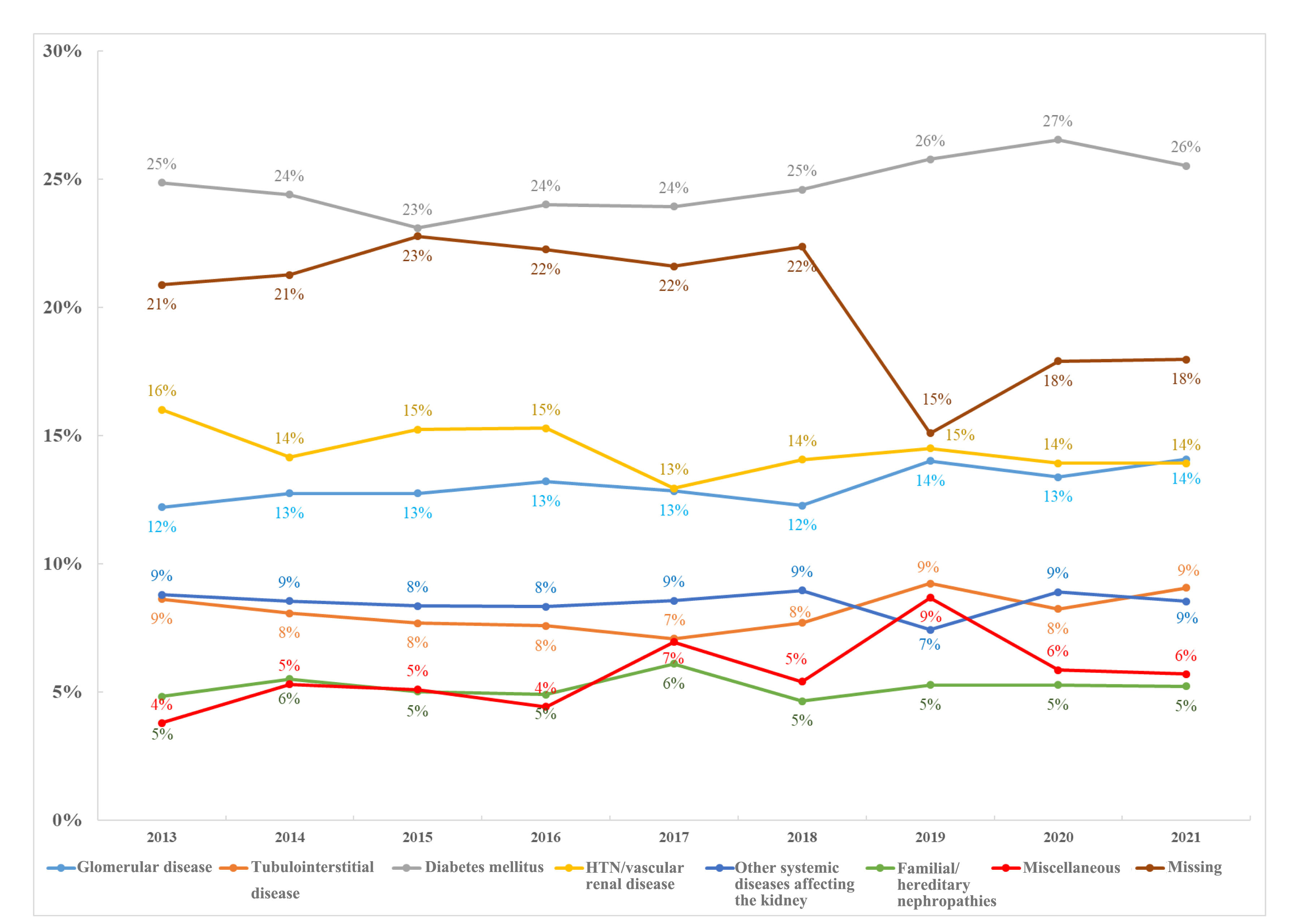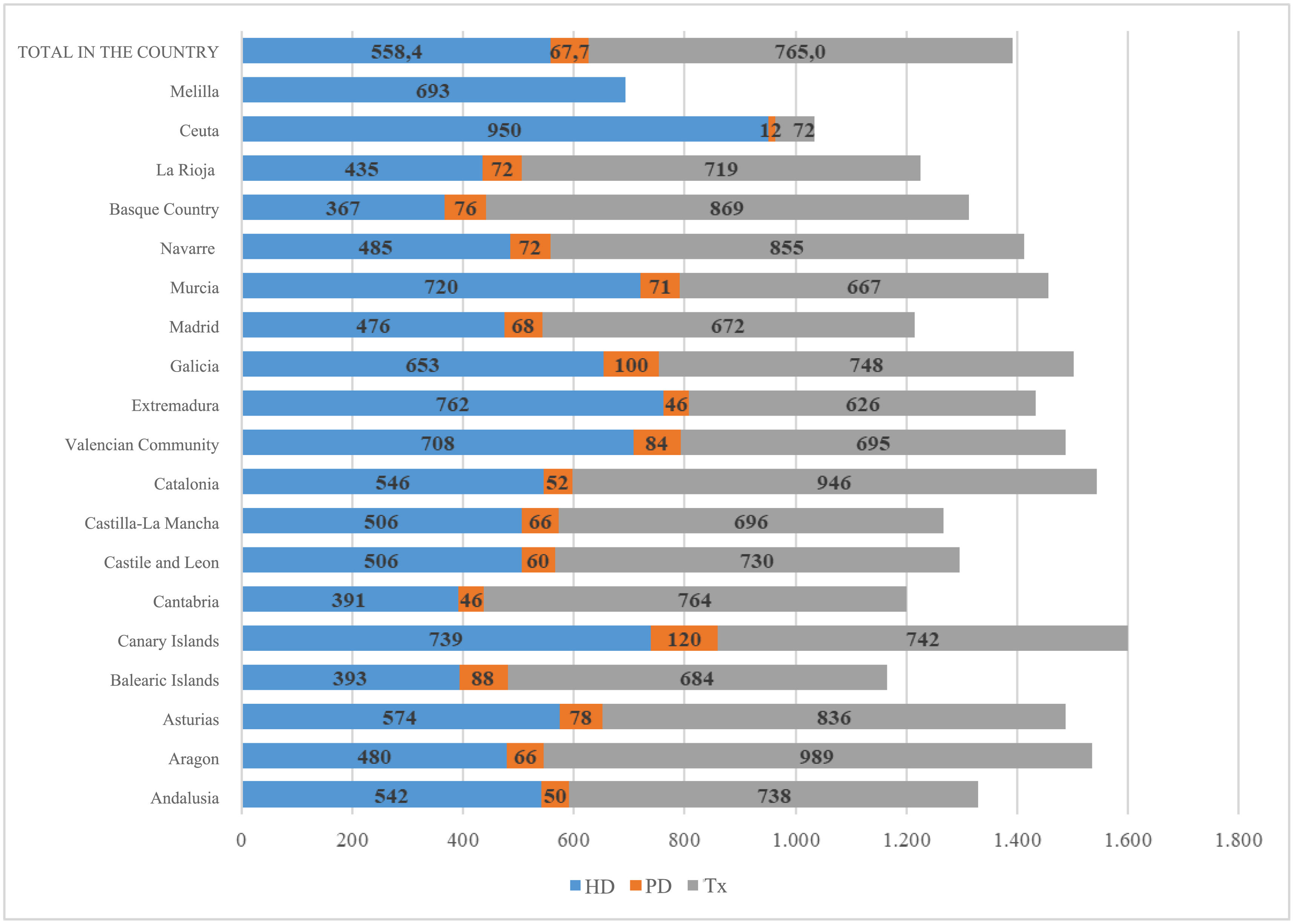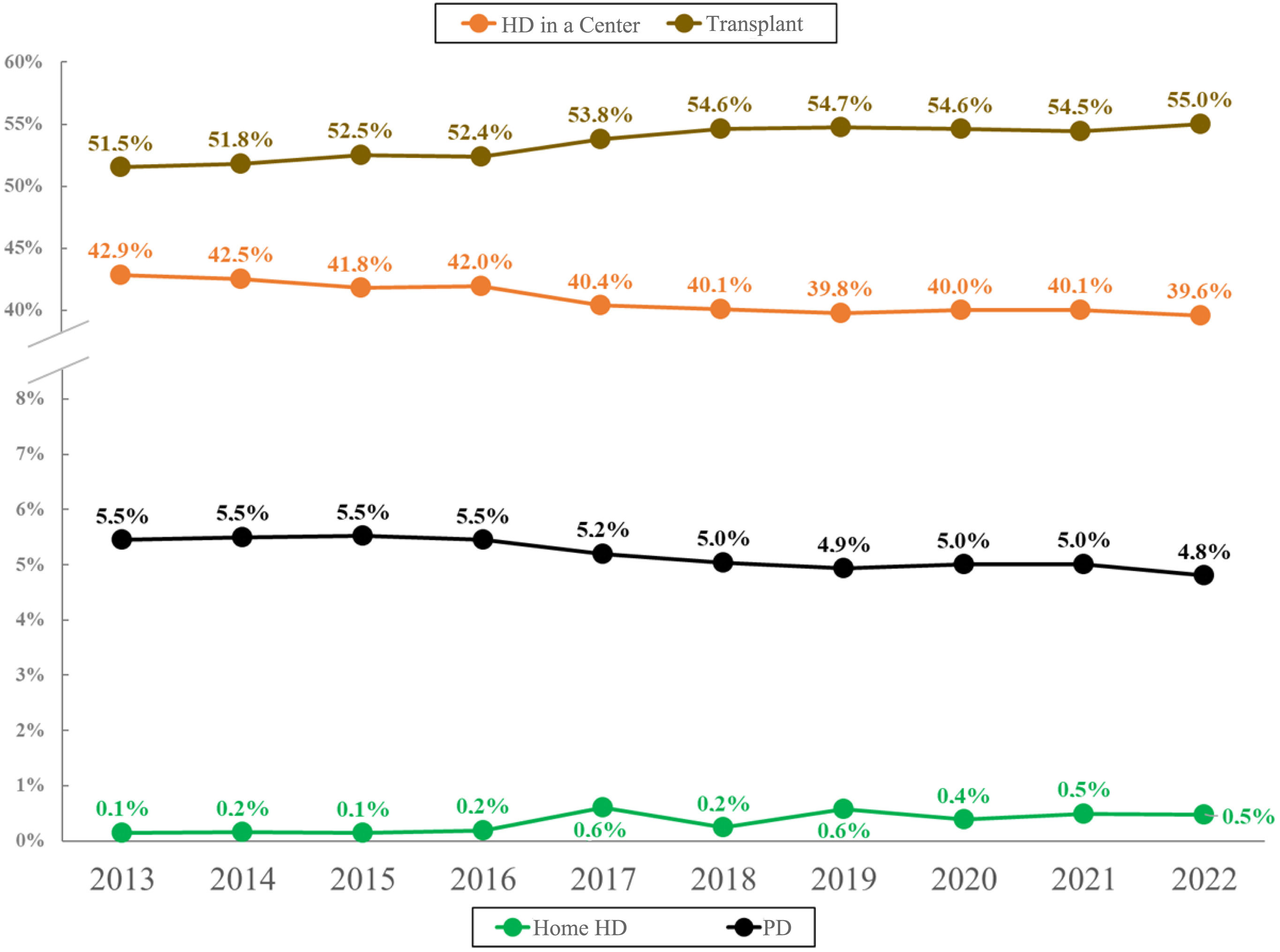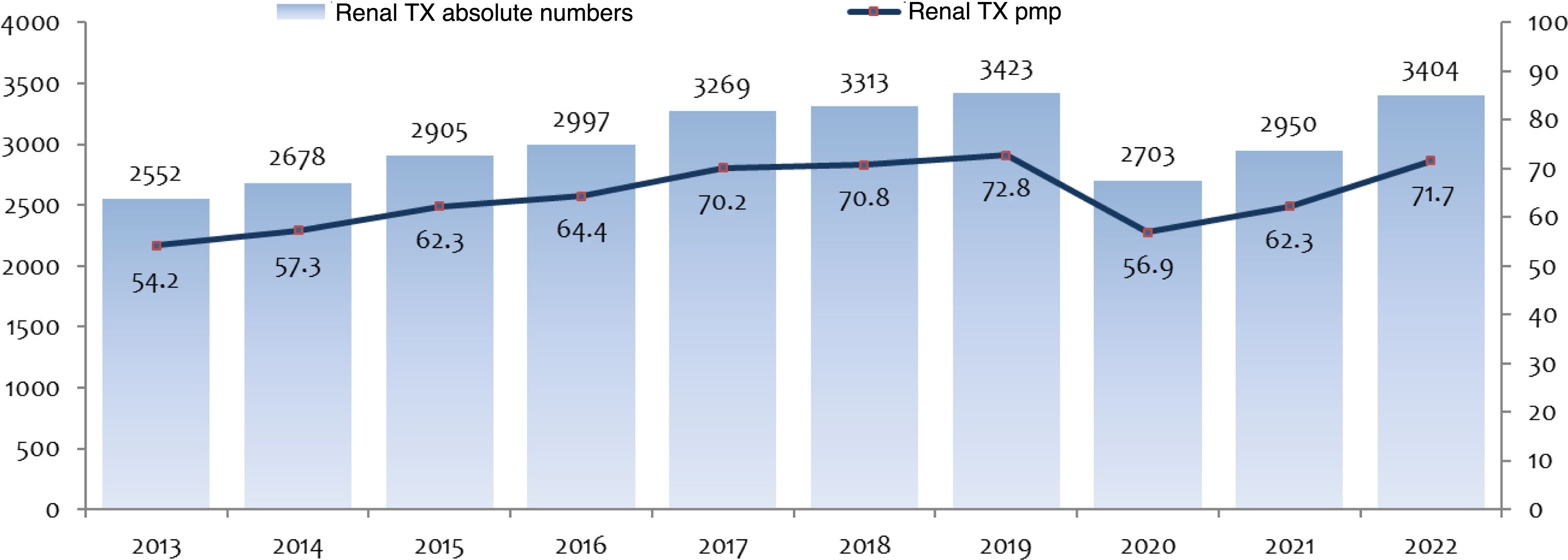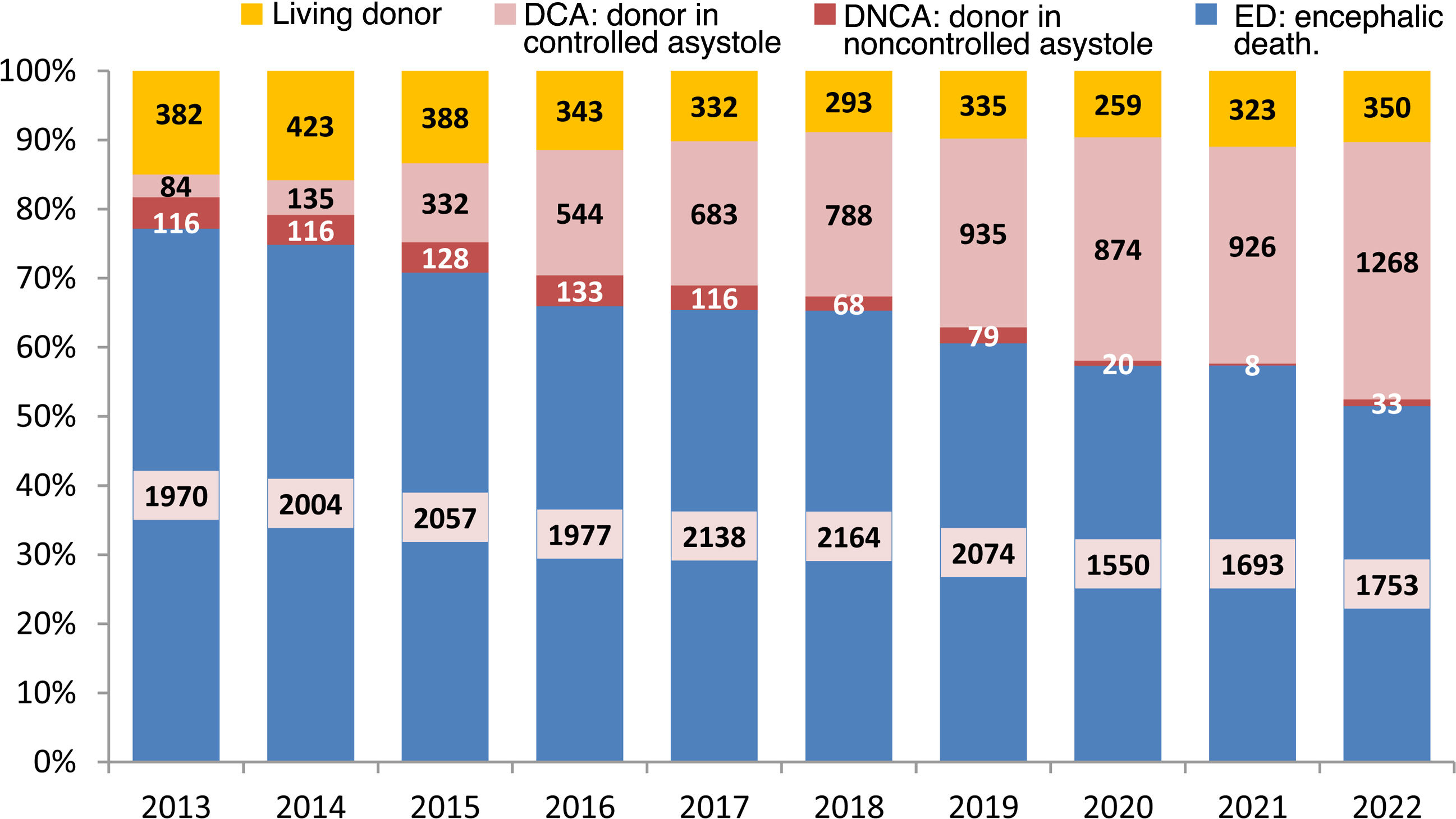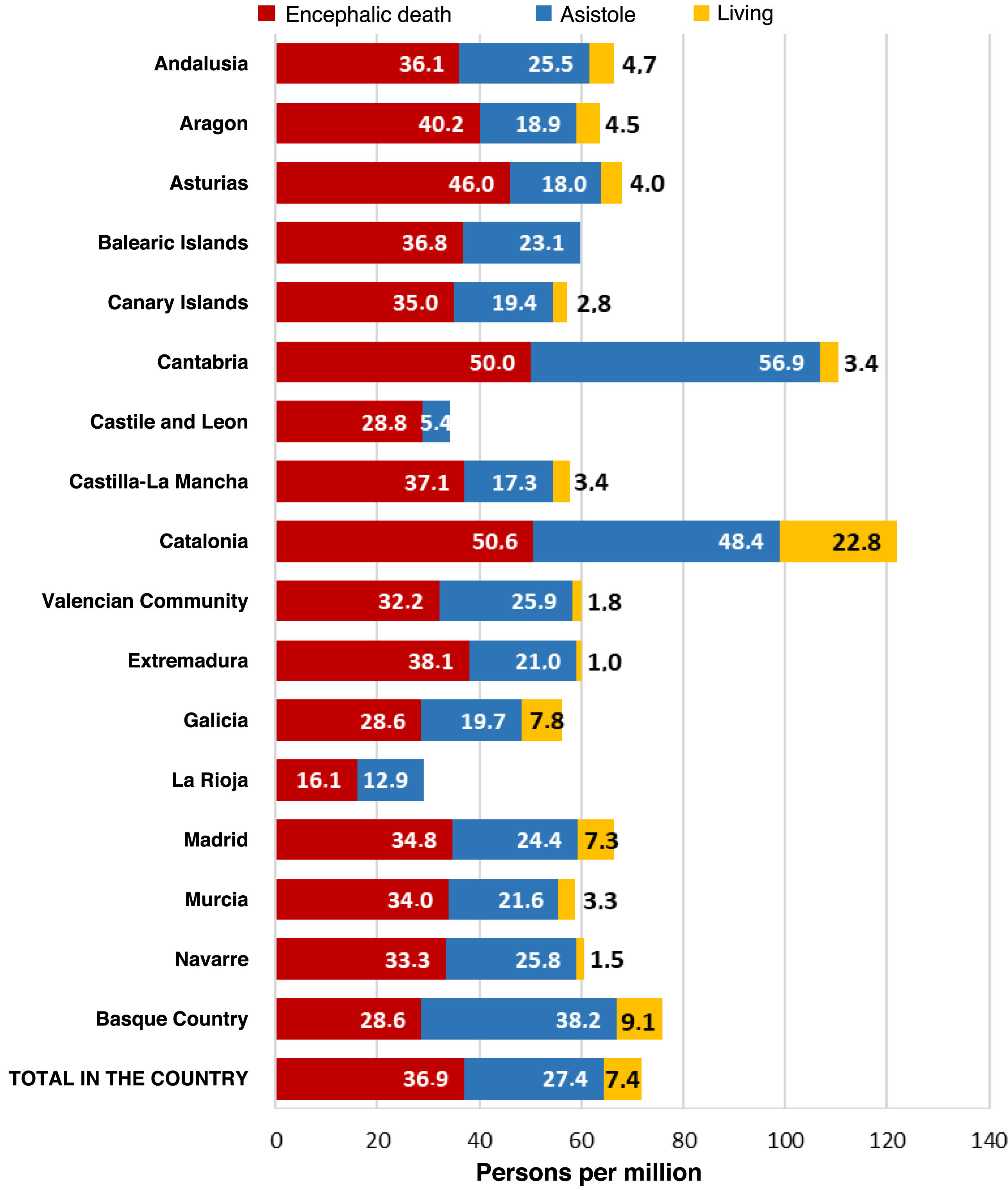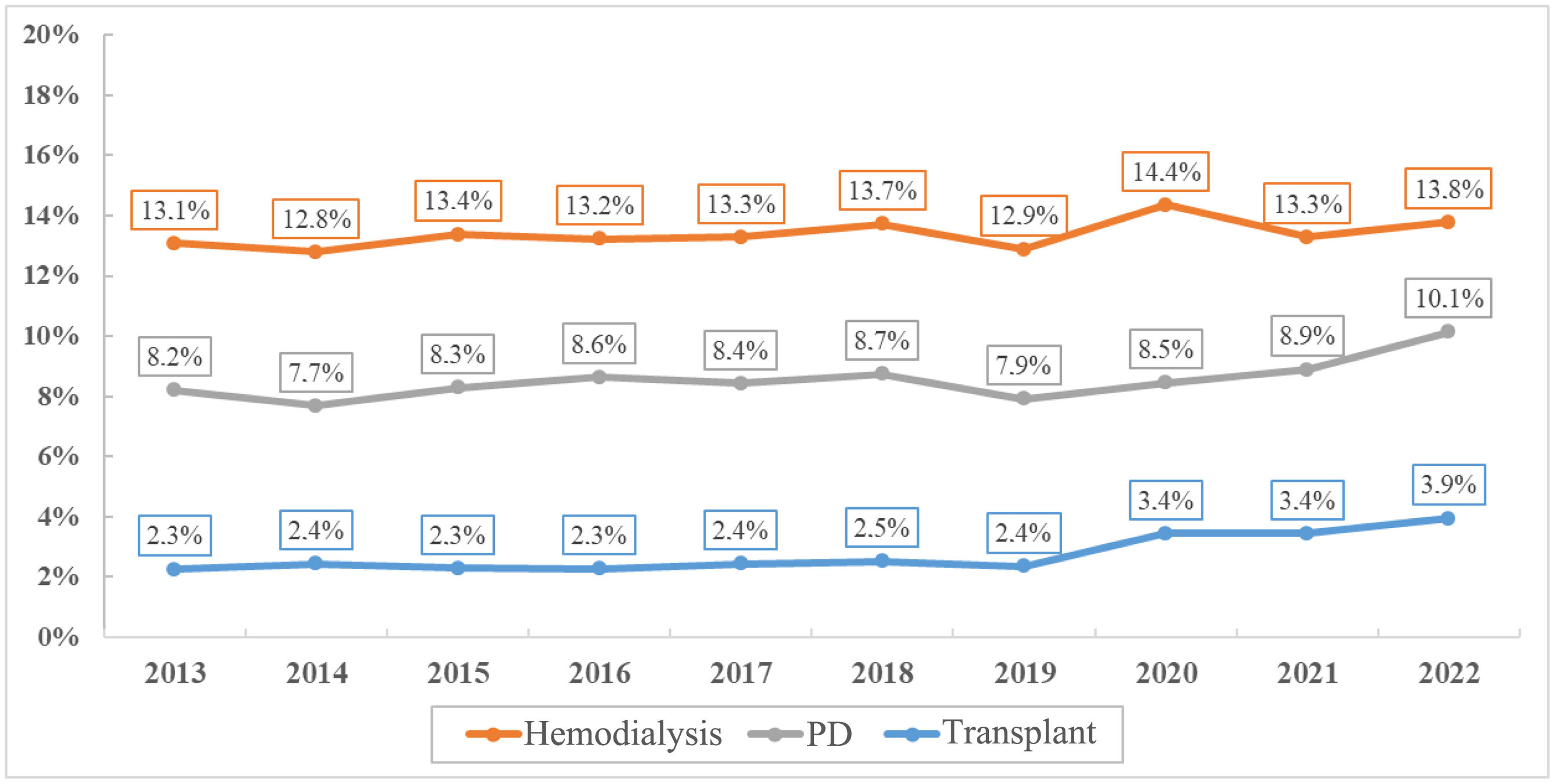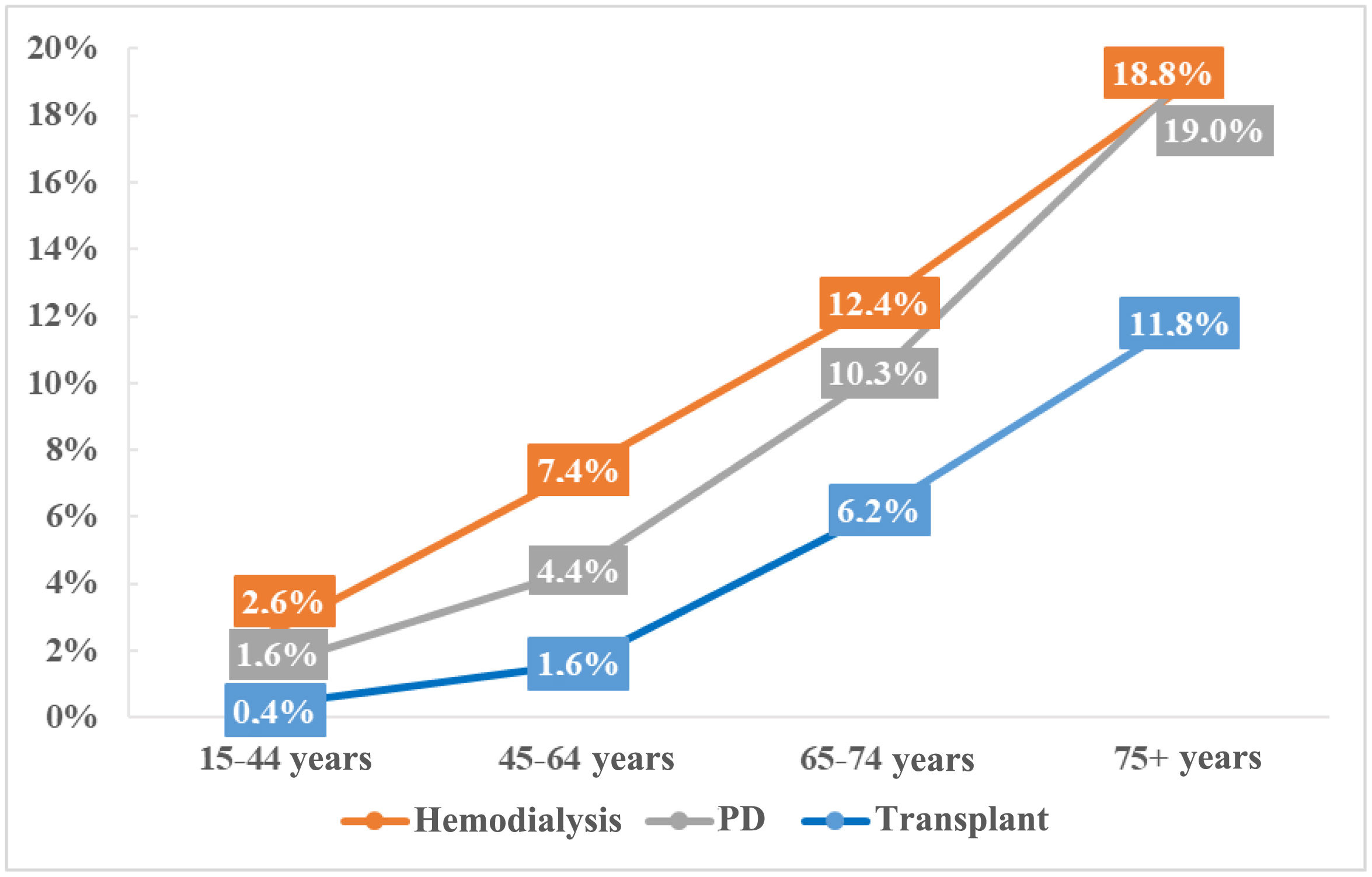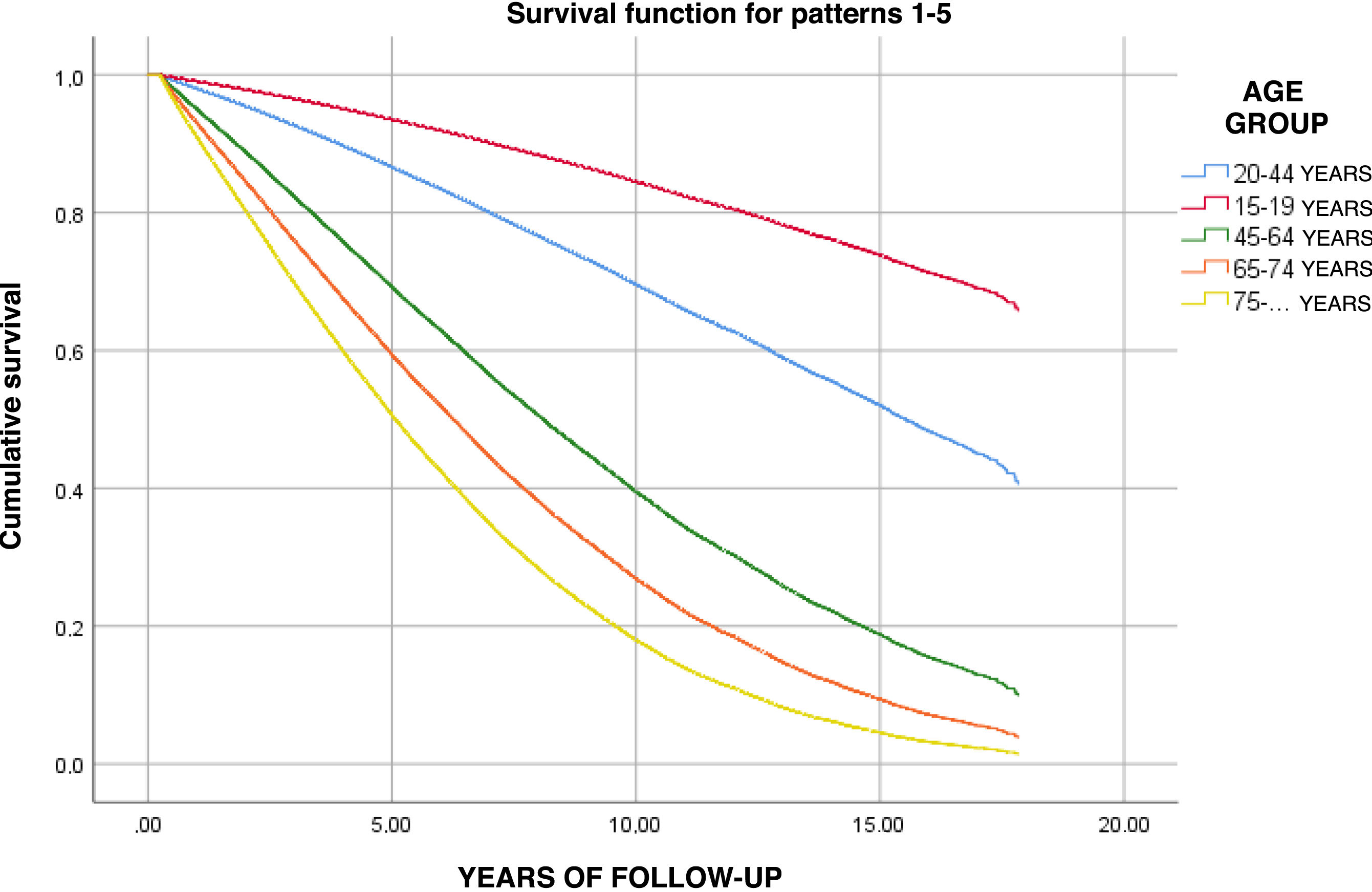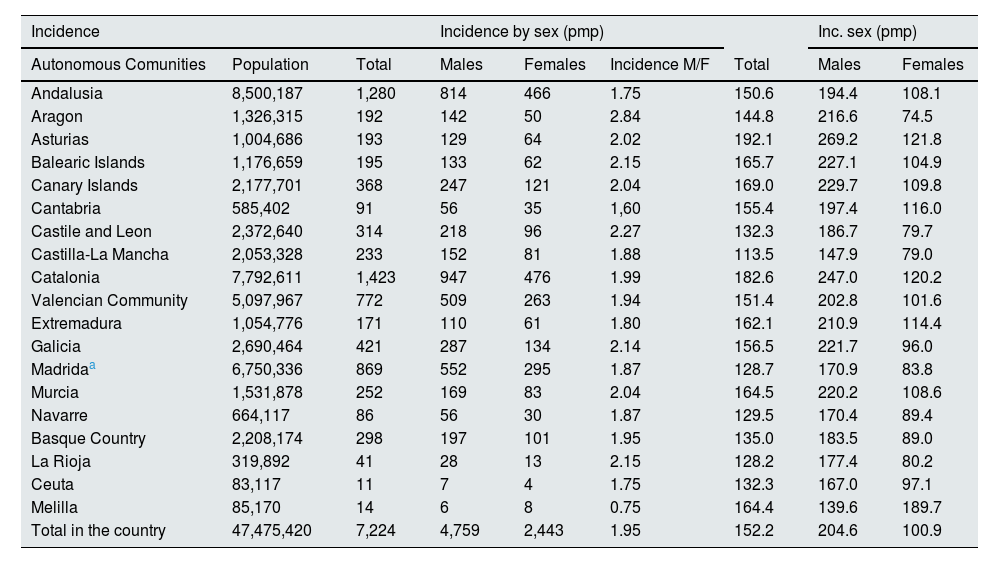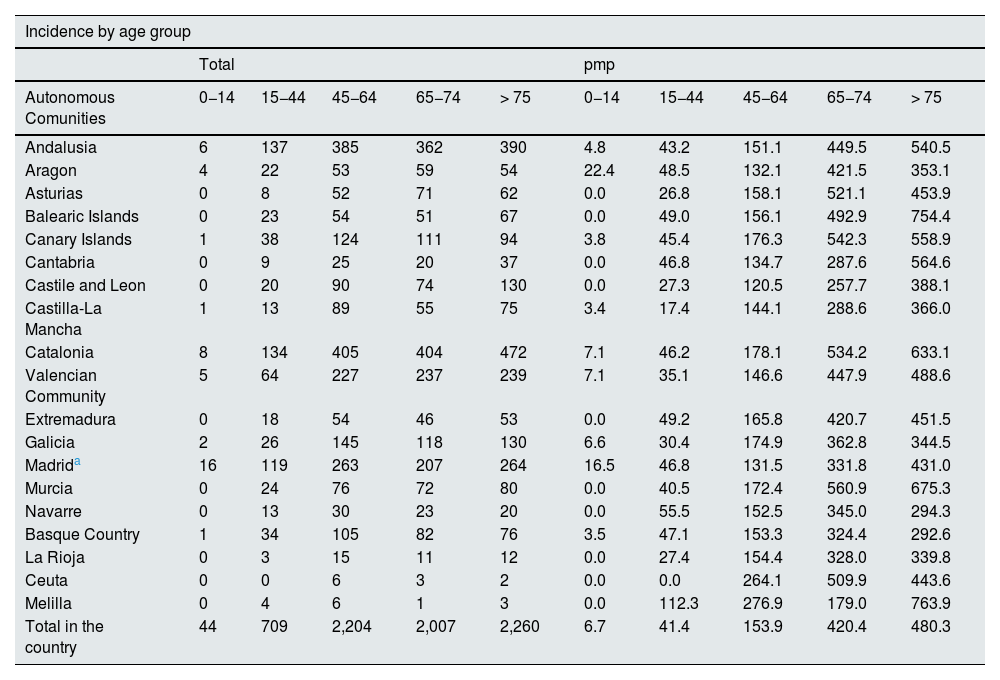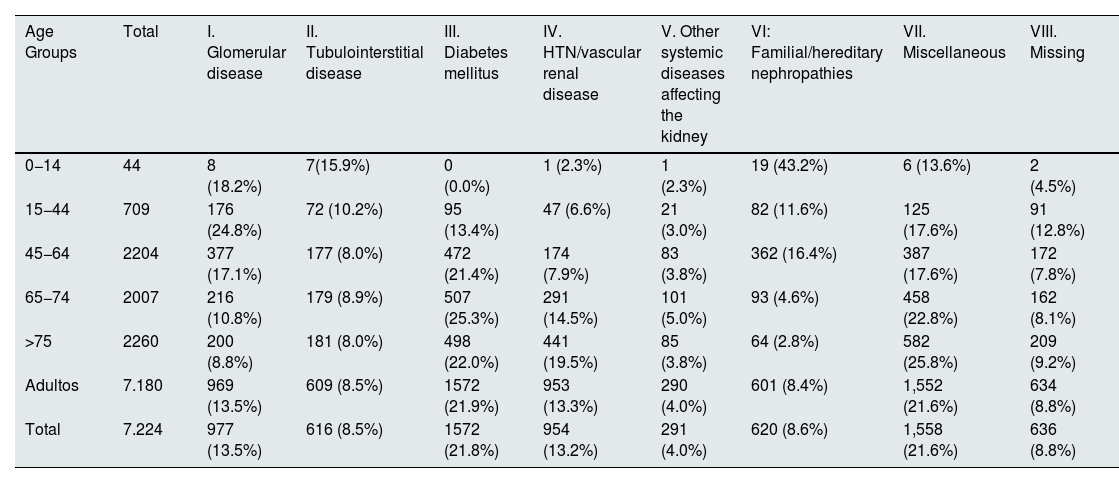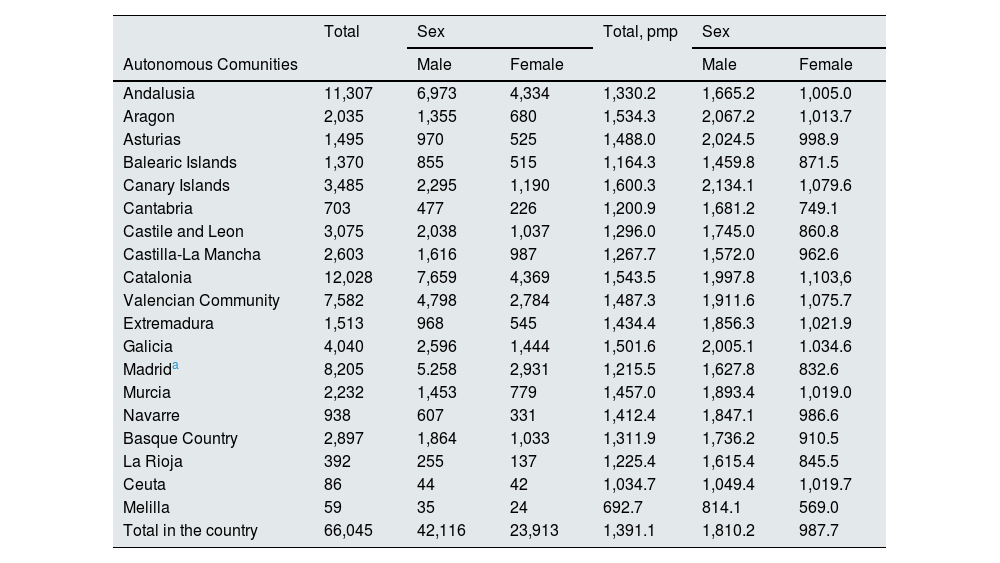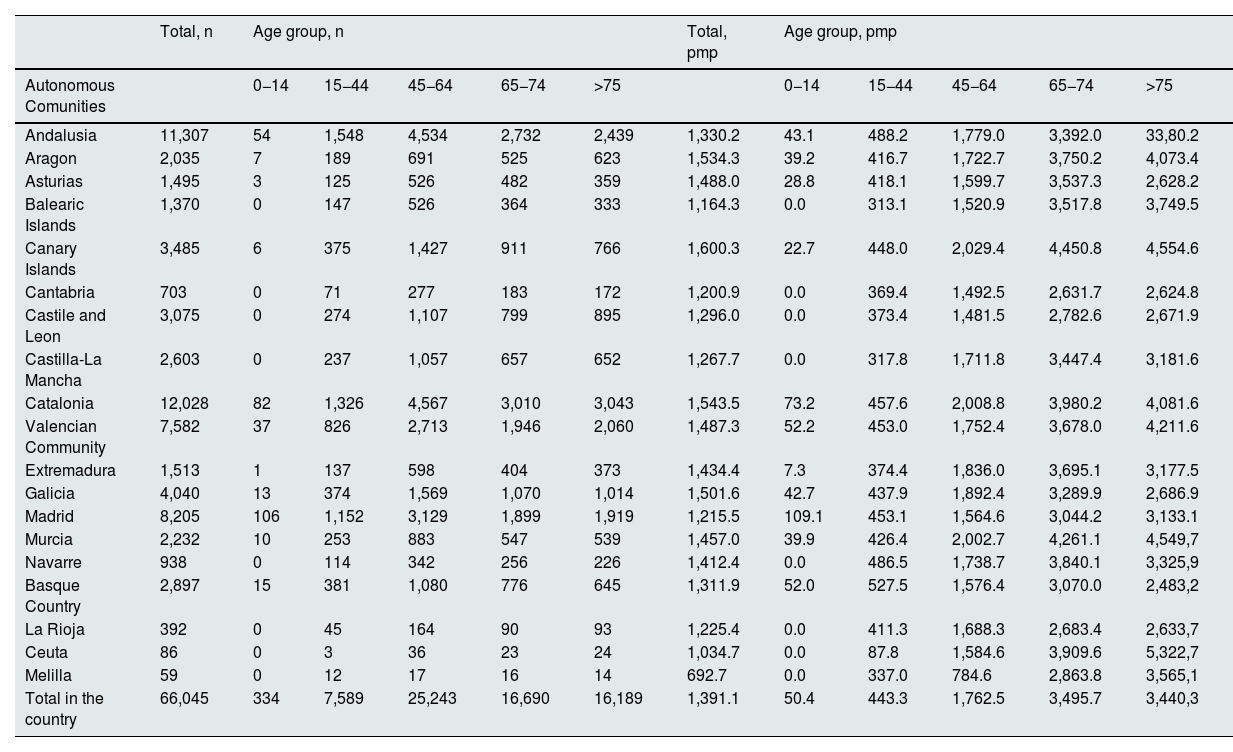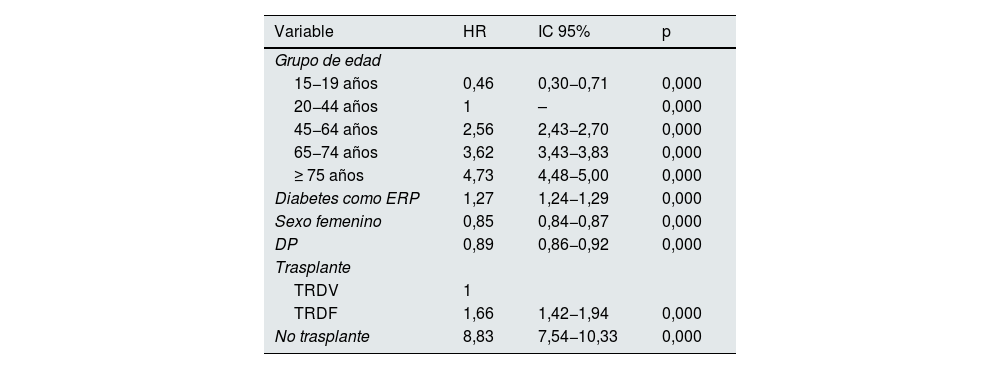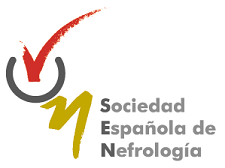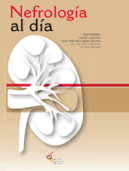Chronic kidney disease (CKD) will be the second leading cause of death in Spain by 2100. The Spanish Renal Disease Registry (REER) records the incidence, prevalence and mortality of all patients requiring renal replacement therapy (RRT) in Spain.
MethodsData are provided by Spanish autonomous regions and cities and the Organización Nacional de Trasplantes. Incidence and prevalence rates of RRT have been calculated (considering the Spanish population according to annual data from the Instituto Nacional de Estadística), as well as mortality of patients on RRT in our country during the period 2013–2022.
ResultsThe incidence rate of RRT increased by 21% from 2013 to 2019, and stabilized thereafter, with a value of 152.2 cases per million population (pmp) in 2022, of which 77.8% were on haemodialysis (HD), 16.7% on peritoneal dialysis (PD) and 5.5% received a preemptive kidney transplant. Diabetes was the leading cause of CKD requiring RRT (21.8%), followed by other causes (21.6%). The incidence rate of RRT was 2-fold higher in men than in women, with large regional differences (1.93-fold for men and 2.55-fold for women in regions with the highest and lowest incidence rates).
The prevalence rate of RRT was 1,391.1 pmp in 2022, showing a progressive increase over the last decade, mainly at the expense of an increase in the transplant population (765.0 pmp, 55.0%).
In 2022, 3,404 kidney transplants were performed in Spain (71.7 pmp), which situates it as a world leader. The most frequent donor type was the donor after the neurological determination of death (51.5%), followed by the donor after the circulatory determination of death (37%).
The overall annual mortality of RRT patients was 8.4% (13.8% for HD, 10.1% for PD and 3.9% for transplantation).
ConclusionsAlthough it has stabilized somewhat in recent years, the incidence and prevalence of RRT continues to rise in Spain. Additional measures must be adopted to harmonize and optimize kidney health care.
La enfermedad renal crónica (ERC) será la segunda causa de muerte en España en el año 2100. El Registro Español de Enfermos Renales (REER) recopila información sobre la incidencia, la prevalencia y la mortalidad de todos los pacientes en terapia renal sustitutiva (TRS) en España.
MétodosLos datos del REER proceden de los remitidos por las comunidades autónomas (CCAA) y las ciudades autónomas, así como los aportados por la Organización Nacional de Trasplantes. Se ha calculado la incidencia y la prevalencia de la TRS (atendiendo a la población española conforme a los datos anuales del Instituto Nacional de Estadística) y la mortalidad de los pacientes en TRS en nuestro país durante el periodo 2013–2022.
ResultadosLa tasa de incidencia de TRS creció un 21% entre 2013 y 2019, estabilizándose desde entonces y siendo de 152,2 personas por millón (pmp) en 2022, correspondiendo un 77,8% a hemodiálisis (HD), un 16,7% a diálisis peritoneal (DP) y un 5,5% a trasplante renal. La diabetes es la primera causa de ERC con necesidad de TRS (21,8%), seguida de miscelánea (21,6%). La tasa de incidencia de TRS fue dos veces mayor en hombres que en mujeres, con grandes diferencias entre CCAA (1.93 veces en hombres y 2.55 en mujeres entre aquellas con mayor y menor incidencia).
La tasa de prevalencia de TRS del año 2022 fue de 1.391,1 pmp, con un ascenso progresivo en la última década, principalmente a expensas de un aumento en la población trasplantada renal (765,0 pmp, 55,0%).
En el año 2022, se realizaron 3.404 trasplantes renales en España (71,7 pmp), que mantiene el liderazgo mundial. La donación procede principalmente de la muerte encefálica (51,5%), seguida de la donación en asistolia (37%).
La mortalidad global de los pacientes en TRS fue del 8,4% anual (13,8% en HD, 10,1% en DP y 3,9% en trasplante).
ConclusionesA pesar de una cierta estabilización en los últimos años, la incidencia y prevalencia de pacientes en TRS sigue en aumento en España, aunque con una amplia variabilidad entre CCAA. Es preceptivo adoptar medidas adicionales que permitan homogeneizar y optimizar la atención sanitaria a la ERC.
Chronic kidney disease will be the second leading cause of death in the year 2100.1 The Spanish Registry of Renal Disease (REER) is an essential source of data to know the incidence, prevalence and mortality of patients on renal replacement therapy (RRT) in Spain. The REER is the result of a collaborative effort between the Renal Disease Registries of the Autonomous Communities and Autonomous Cities, the Spanish Society of Nephrology (S.E.N) and the National Transplant Organization (ONT), which is responsible for data management and analysis. In addition to collaborating with the European Renal Association (ERA) and the United States Renal Data System (USRDS) registry, the REER report has been presented at the annual congress of the S.E.N. since 1996 and it is intended that, from now on, it will be published annually in the journal NEFROLOGÍA.
In recent years, nephrology has progressed in the management of chronic kidney disease (CKD), with extensive development and approval of new treatments and diagnostic techniques.2 Despite this, each year a greater number of patients require RRT both in Spain and globally.3 In 2022, the incidence of RRT in Spain was the fifteenth highest in Europe (out of a total of 34).3,4 The prevalence of RRT in Spain was the third highest in Europe (out of a total of 29 European countries reporting data).3,4 In comparison with the United States, incidence and prevalence were substantially better in Spain: 410 patients per million population (pmp) and 2,436 pmp, respectively.5
The aim of this report is to update the data on prevalence, incidence, and mortality of patients with RRT in Spain for the year 2022, comparing the evolution of the situation during the last 10 years
MethodsData sources and study populationThe present study collected data on patients on RRT reported to the REER between 2013 and 2022 and derived from those submitted by the autonomous communities (ACs) and autonomous cities of Spain to the ONT. Data on patients with a renal graft were complemented with data from the ONT's CORE information system. The national reference population and that of each autonomous community as of January 1 of the year under study was obtained from the National Institute of Statistics.6
Incidence and prevalence data were calculated on the basis of aggregate data (the Autonomous Communities submit these data on an individualized or aggregated basis), whereas the survival analysis was performed on the basis of individual patient data provided by the autonomous community registries (it included all the Autonomous Communities, with the exception of the Balearic Islands, Ceuta and Melilla, which represents a population coverage of 97%).
VariablesEpidemiological data were collected (age, sex), etiology of primary kidney disease (PKD), type of RRT, and mortality. With regard to etiology, the definition and grouping have varied throughout the existence of the REER; since 2022 adopted what was proposed by the ERA registry,4 which includes the groups of glomerular disease, tubulointerstitial disease, diabetes mellitus, renal vascular disease, other systemic diseases, familial/hereditary nephropathies, and miscellaneous (among which are included those that are not affiliated). The previous, classification used grouped the patients into the following categories7: glomerulonephritis, pyelonephritis/interstitial, polycystic disease, diabetes mellitus, vascular, systemic, hereditary, other and nonaffiliated.
The causes of death have also undergone variations in their coding. Until 2022, causes of death were grouped into cardiac, vascular, sudden death, infectious, cancer, hepatic, gastrointestinal, psychological/social, accident, other and unaffiliated. Since 2022, the ERA-EDTA4 classification has also been adopted, which classifies them into: I. Myocardial ischemia/infarction. II.Cardiac failure. III.Cardiac arrest/other cause/unknown. IV. Stroke. V. Infection. VI. Suicide/refusal of treatment. VII. Treatment abandonment. VIII. Cachexia.
IX. Neoplasia. X. Miscellaneous. XI. Unknown/unavailable.
Statistical methodsData are expressed as absolute numbers and frequencies (percentages), as well as rates per million population (pmp). Incidence refers to the number of patients initiating RRT during each of the years of the study period, and prevalence refers to the total number of patients alive on RRT at 31 December of each year. The renal transplant rate is calculated as the number of transplants performed in a year on the reference population.
For the calculation of survival, there have been used, data on individual patients from those Autonomous Communities that have provided them and authorized their use. In order to merge all the data, the data were previously cleaned and converted to obtain a common format that would allow their integration, with the variables and information required for the analysis. Incident patients since 2004 for whom information was available, older than 15 years and with a follow-up of more than 3 months, were included. Patients with renal transplantation as the first RRT and patients from other registries were excluded from the analysis. The Kaplan-Meier method was used to calculate the unadjusted survival probability and the LogRank test was used to compare survival curves between groups.
A Cox proportional hazards model was developed to study the potential predictors of survival using age, sex, RRT modality, diabetic nephropathy as ERP and having received at least one transplant as adjustment variables. Death was considered as an event, censoring recovery of renal function, transfer to another registry and loss to follow-up.
Similarly, for the analysis of survival from the first transplant, the same methodology was used, censoring patients lost to follow-up and considering patient death, retransplantation or graft failure as an event.
For the comparison of survival data (overall and transplant) between Spain and the ERA as a whole, it was used4 the report provided individually by the ERA to the participating registries. The methodology used for this analysis is that applied by the ERA.
The analysis was performed by intention-to-treat. The software used was Microsoft Excel 365 (v. 2404®) and SPSS v.25.0 for Windows.
ResultsIncidenceDuring 2022, 7,224 patients initiated RRT, of whom 4,759 (66%) were male. The incidence was 152.2 pmp (204.6 pmp in males and 100.9 pmp in females) (Table 1). Regarding RRT modality, 117.9 pmp (78%) initiated RRT with hemodialysis (HD), 24.7 pmp (17%) with peritoneal dialysis (PD), and 7.7 pmp (5%) received early renal transplantation. Fig. 1 shows the incidence by ACs according to RRT modality, presenting the differences between regions. Specifically, the incidence rate of RRT was 1.93 times higher in men between Asturias and Melilla, and 2.55 times higher in women between Melilla and Aragon.
Incidence of RRT overall and by sex in Spain and each autonomous communities in 2022.
| Incidence | Incidence by sex (pmp) | Inc. sex (pmp) | ||||||
|---|---|---|---|---|---|---|---|---|
| Autonomous Comunities | Population | Total | Males | Females | Incidence M/F | Total | Males | Females |
| Andalusia | 8,500,187 | 1,280 | 814 | 466 | 1.75 | 150.6 | 194.4 | 108.1 |
| Aragon | 1,326,315 | 192 | 142 | 50 | 2.84 | 144.8 | 216.6 | 74.5 |
| Asturias | 1,004,686 | 193 | 129 | 64 | 2.02 | 192.1 | 269.2 | 121.8 |
| Balearic Islands | 1,176,659 | 195 | 133 | 62 | 2.15 | 165.7 | 227.1 | 104.9 |
| Canary Islands | 2,177,701 | 368 | 247 | 121 | 2.04 | 169.0 | 229.7 | 109.8 |
| Cantabria | 585,402 | 91 | 56 | 35 | 1,60 | 155.4 | 197.4 | 116.0 |
| Castile and Leon | 2,372,640 | 314 | 218 | 96 | 2.27 | 132.3 | 186.7 | 79.7 |
| Castilla-La Mancha | 2,053,328 | 233 | 152 | 81 | 1.88 | 113.5 | 147.9 | 79.0 |
| Catalonia | 7,792,611 | 1,423 | 947 | 476 | 1.99 | 182.6 | 247.0 | 120.2 |
| Valencian Community | 5,097,967 | 772 | 509 | 263 | 1.94 | 151.4 | 202.8 | 101.6 |
| Extremadura | 1,054,776 | 171 | 110 | 61 | 1.80 | 162.1 | 210.9 | 114.4 |
| Galicia | 2,690,464 | 421 | 287 | 134 | 2.14 | 156.5 | 221.7 | 96.0 |
| Madridaa | 6,750,336 | 869 | 552 | 295 | 1.87 | 128.7 | 170.9 | 83.8 |
| Murcia | 1,531,878 | 252 | 169 | 83 | 2.04 | 164.5 | 220.2 | 108.6 |
| Navarre | 664,117 | 86 | 56 | 30 | 1.87 | 129.5 | 170.4 | 89.4 |
| Basque Country | 2,208,174 | 298 | 197 | 101 | 1.95 | 135.0 | 183.5 | 89.0 |
| La Rioja | 319,892 | 41 | 28 | 13 | 2.15 | 128.2 | 177.4 | 80.2 |
| Ceuta | 83,117 | 11 | 7 | 4 | 1.75 | 132.3 | 167.0 | 97.1 |
| Melilla | 85,170 | 14 | 6 | 8 | 0.75 | 164.4 | 139.6 | 189.7 |
| Total in the country | 47,475,420 | 7,224 | 4,759 | 2,443 | 1.95 | 152.2 | 204.6 | 100.9 |
pmp, persons per million population; RRT, renal replacement therapy.
Incidence rate (pmp) by autonomous community according to RRT modality.
PD: peritoneal dialysis; HD: hemodialysis; pmp: persons per million population; RRT: renal replacement therapy; TX: transplantation.
Nota: En ingles el signo de decimal es un punto (.) en vez de una coma (,) por favor cambiar “,” por”.”
The incidence rate of RRT increased by 21% between 2013 and 2019 (151.7 vs 125.4 pmp); then it stabilized, with a trough in 2020 probably related to the COVID-19 pandemic (Fig. 2). During the decade of the study, HD as a starting RRT increased by 19.4%, PD by 20.9% and early transplantation by 64.7% (Fig. 2). The age group with the highest incidence was over 74 years (480.3 pmp), followed by 65-74 years (420.4 pmp), 45-64 years (153.9 pmp), 15-44 years (41.4 pmp) and under 15 years (6.7 pmp). Table 2 shows the incidence of the age groups in each of the regions ( Autonomic Communities). Regarding the etiology of CKD, the most frequent was diabetes mellitus (21.8%), followed by miscellaneous (21.6%) and glomerular disease (13.5%) (Fig. 3). As shown in Table 3, the etiology of CKD presents differences according to age group. The evolution of etiology in the period 2013-2021 (prior to the change in the etiology nomenclature) shows that diabetes has been the most frequent cause of CKD throughout the entire study period in incident patients, followed by non-filiated , with a downward trend in both in the 2022 data (Figs. 3 and 4).
Evolution of the overall incidence rate (pmp) during the 2013-2022 period in the different types of RRT.
PD: peritoneal dialysis; pmp: persons per million population; RRT: renal replacement therapy.
Nota: En ingles el signo de decimal es un punto (.) en vez de una coma (,) por favor cambiar “,” por”.”
Total = Total Hemodiálisis: Hemodialysis Trasplante = Transplant DP = PD
Incidence of RRT by age group in the different territories (Autonomous Comunities) in 2022.
| Incidence by age group | ||||||||||
|---|---|---|---|---|---|---|---|---|---|---|
| Total | pmp | |||||||||
| Autonomous Comunities | 0−14 | 15−44 | 45−64 | 65−74 | > 75 | 0−14 | 15−44 | 45−64 | 65−74 | > 75 |
| Andalusia | 6 | 137 | 385 | 362 | 390 | 4.8 | 43.2 | 151.1 | 449.5 | 540.5 |
| Aragon | 4 | 22 | 53 | 59 | 54 | 22.4 | 48.5 | 132.1 | 421.5 | 353.1 |
| Asturias | 0 | 8 | 52 | 71 | 62 | 0.0 | 26.8 | 158.1 | 521.1 | 453.9 |
| Balearic Islands | 0 | 23 | 54 | 51 | 67 | 0.0 | 49.0 | 156.1 | 492.9 | 754.4 |
| Canary Islands | 1 | 38 | 124 | 111 | 94 | 3.8 | 45.4 | 176.3 | 542.3 | 558.9 |
| Cantabria | 0 | 9 | 25 | 20 | 37 | 0.0 | 46.8 | 134.7 | 287.6 | 564.6 |
| Castile and Leon | 0 | 20 | 90 | 74 | 130 | 0.0 | 27.3 | 120.5 | 257.7 | 388.1 |
| Castilla-La Mancha | 1 | 13 | 89 | 55 | 75 | 3.4 | 17.4 | 144.1 | 288.6 | 366.0 |
| Catalonia | 8 | 134 | 405 | 404 | 472 | 7.1 | 46.2 | 178.1 | 534.2 | 633.1 |
| Valencian Community | 5 | 64 | 227 | 237 | 239 | 7.1 | 35.1 | 146.6 | 447.9 | 488.6 |
| Extremadura | 0 | 18 | 54 | 46 | 53 | 0.0 | 49.2 | 165.8 | 420.7 | 451.5 |
| Galicia | 2 | 26 | 145 | 118 | 130 | 6.6 | 30.4 | 174.9 | 362.8 | 344.5 |
| Madrida | 16 | 119 | 263 | 207 | 264 | 16.5 | 46.8 | 131.5 | 331.8 | 431.0 |
| Murcia | 0 | 24 | 76 | 72 | 80 | 0.0 | 40.5 | 172.4 | 560.9 | 675.3 |
| Navarre | 0 | 13 | 30 | 23 | 20 | 0.0 | 55.5 | 152.5 | 345.0 | 294.3 |
| Basque Country | 1 | 34 | 105 | 82 | 76 | 3.5 | 47.1 | 153.3 | 324.4 | 292.6 |
| La Rioja | 0 | 3 | 15 | 11 | 12 | 0.0 | 27.4 | 154.4 | 328.0 | 339.8 |
| Ceuta | 0 | 0 | 6 | 3 | 2 | 0.0 | 0.0 | 264.1 | 509.9 | 443.6 |
| Melilla | 0 | 4 | 6 | 1 | 3 | 0.0 | 112.3 | 276.9 | 179.0 | 763.9 |
| Total in the country | 44 | 709 | 2,204 | 2,007 | 2,260 | 6.7 | 41.4 | 153.9 | 420.4 | 480.3 |
pmp, persons per million population; RRT, renal replacement therapy.
Distribution of incident patients on RRT in 2022 according to PRD.
PRD: primary renal disease; RRT: renal replacement therapy.
Nota: En ingles el signo de decimal es un punto (.) en vez de una coma (,) por favor cambiar “,” por”.”
I. Glomerular diseaseII. Tubulointerstitial diseaseIII. Diabetes mellitusIV. HTN/vascular renal diseaseV. Other systemic diseases affecting the kidneyVI: Familial/hereditary nephropathiesVII. MiscellaneousVIII. Missing
Distribution of etiology of CKD in incident RRT in different age groups in 2022.
| Age Groups | Total | I. Glomerular disease | II. Tubulointerstitial disease | III. Diabetes mellitus | IV. HTN/vascular renal disease | V. Other systemic diseases affecting the kidney | VI: Familial/hereditary nephropathies | VII. Miscellaneous | VIII. Missing |
|---|---|---|---|---|---|---|---|---|---|
| 0−14 | 44 | 8 (18.2%) | 7(15.9%) | 0 (0.0%) | 1 (2.3%) | 1 (2.3%) | 19 (43.2%) | 6 (13.6%) | 2 (4.5%) |
| 15−44 | 709 | 176 (24.8%) | 72 (10.2%) | 95 (13.4%) | 47 (6.6%) | 21 (3.0%) | 82 (11.6%) | 125 (17.6%) | 91 (12.8%) |
| 45−64 | 2204 | 377 (17.1%) | 177 (8.0%) | 472 (21.4%) | 174 (7.9%) | 83 (3.8%) | 362 (16.4%) | 387 (17.6%) | 172 (7.8%) |
| 65−74 | 2007 | 216 (10.8%) | 179 (8.9%) | 507 (25.3%) | 291 (14.5%) | 101 (5.0%) | 93 (4.6%) | 458 (22.8%) | 162 (8.1%) |
| >75 | 2260 | 200 (8.8%) | 181 (8.0%) | 498 (22.0%) | 441 (19.5%) | 85 (3.8%) | 64 (2.8%) | 582 (25.8%) | 209 (9.2%) |
| Adultos | 7.180 | 969 (13.5%) | 609 (8.5%) | 1572 (21.9%) | 953 (13.3%) | 290 (4.0%) | 601 (8.4%) | 1,552 (21.6%) | 634 (8.8%) |
| Total | 7.224 | 977 (13.5%) | 616 (8.5%) | 1572 (21.8%) | 954 (13.2%) | 291 (4.0%) | 620 (8.6%) | 1,558 (21.6%) | 636 (8.8%) |
CKD: chronic kidney disease; HTN: hypertension; RRT: renal replacement therapy.
Evolution of the distribution of PRD etiology (%) in incident patients on RRT in the period 2013-2021. (The year 2022 has not been included due to the change adopted in the REER classification).
PRD: primary renal disease; RRT: renal replacement therapy.
I. Glomerular diseaseII. Tubulointerstitial diseaseIII. Diabetes mellitusIV. HTN/vascular renal diseaseV. Other systemic diseases affecting the kidneyVI: Familial/hereditary nephropathiesVII. MiscellaneousVIII. Missing
The prevalence of RRT in Spain in 2022 was 66,045 persons, of whom 42,116 (63.8%) were male. The overall prevalence was 1,391.1 pmp, being 1,810.2 pmp in males and 987.7 pmp in females, with heterogeneity in the different territories (Table 4). The prevalence of RRT was highest in patients older than 65 years, with important differences between territories (Table 5). In the last decade, the prevalence of RRT in Spain has increased by 24.1% (Table 6).
Prevalence of RRT in 2022 in the different autonomous communities and its distribution by sex.
| Total | Sex | Total, pmp | Sex | |||
|---|---|---|---|---|---|---|
| Autonomous Comunities | Male | Female | Male | Female | ||
| Andalusia | 11,307 | 6,973 | 4,334 | 1,330.2 | 1,665.2 | 1,005.0 |
| Aragon | 2,035 | 1,355 | 680 | 1,534.3 | 2,067.2 | 1,013.7 |
| Asturias | 1,495 | 970 | 525 | 1,488.0 | 2,024.5 | 998.9 |
| Balearic Islands | 1,370 | 855 | 515 | 1,164.3 | 1,459.8 | 871.5 |
| Canary Islands | 3,485 | 2,295 | 1,190 | 1,600.3 | 2,134.1 | 1,079.6 |
| Cantabria | 703 | 477 | 226 | 1,200.9 | 1,681.2 | 749.1 |
| Castile and Leon | 3,075 | 2,038 | 1,037 | 1,296.0 | 1,745.0 | 860.8 |
| Castilla-La Mancha | 2,603 | 1,616 | 987 | 1,267.7 | 1,572.0 | 962.6 |
| Catalonia | 12,028 | 7,659 | 4,369 | 1,543.5 | 1,997.8 | 1,103,6 |
| Valencian Community | 7,582 | 4,798 | 2,784 | 1,487.3 | 1,911.6 | 1,075.7 |
| Extremadura | 1,513 | 968 | 545 | 1,434.4 | 1,856.3 | 1,021.9 |
| Galicia | 4,040 | 2,596 | 1,444 | 1,501.6 | 2,005.1 | 1.034.6 |
| Madrida | 8,205 | 5.258 | 2,931 | 1,215.5 | 1,627.8 | 832.6 |
| Murcia | 2,232 | 1,453 | 779 | 1,457.0 | 1,893.4 | 1,019.0 |
| Navarre | 938 | 607 | 331 | 1,412.4 | 1,847.1 | 986.6 |
| Basque Country | 2,897 | 1,864 | 1,033 | 1,311.9 | 1,736.2 | 910.5 |
| La Rioja | 392 | 255 | 137 | 1,225.4 | 1,615.4 | 845.5 |
| Ceuta | 86 | 44 | 42 | 1,034.7 | 1,049.4 | 1,019.7 |
| Melilla | 59 | 35 | 24 | 692.7 | 814.1 | 569.0 |
| Total in the country | 66,045 | 42,116 | 23,913 | 1,391.1 | 1,810.2 | 987.7 |
pmp: persons per million population; RRT: renal replacement therapy.
Prevalence rate (pmp) of patients on RRT by age groups in the different autonomous communities in 2022.
| Total, n | Age group, n | Total, pmp | Age group, pmp | |||||||||
|---|---|---|---|---|---|---|---|---|---|---|---|---|
| Autonomous Comunities | 0−14 | 15−44 | 45−64 | 65−74 | >75 | 0−14 | 15−44 | 45−64 | 65−74 | >75 | ||
| Andalusia | 11,307 | 54 | 1,548 | 4,534 | 2,732 | 2,439 | 1,330.2 | 43.1 | 488.2 | 1,779.0 | 3,392.0 | 33,80.2 |
| Aragon | 2,035 | 7 | 189 | 691 | 525 | 623 | 1,534.3 | 39.2 | 416.7 | 1,722.7 | 3,750.2 | 4,073.4 |
| Asturias | 1,495 | 3 | 125 | 526 | 482 | 359 | 1,488.0 | 28.8 | 418.1 | 1,599.7 | 3,537.3 | 2,628.2 |
| Balearic Islands | 1,370 | 0 | 147 | 526 | 364 | 333 | 1,164.3 | 0.0 | 313.1 | 1,520.9 | 3,517.8 | 3,749.5 |
| Canary Islands | 3,485 | 6 | 375 | 1,427 | 911 | 766 | 1,600.3 | 22.7 | 448.0 | 2,029.4 | 4,450.8 | 4,554.6 |
| Cantabria | 703 | 0 | 71 | 277 | 183 | 172 | 1,200.9 | 0.0 | 369.4 | 1,492.5 | 2,631.7 | 2,624.8 |
| Castile and Leon | 3,075 | 0 | 274 | 1,107 | 799 | 895 | 1,296.0 | 0.0 | 373.4 | 1,481.5 | 2,782.6 | 2,671.9 |
| Castilla-La Mancha | 2,603 | 0 | 237 | 1,057 | 657 | 652 | 1,267.7 | 0.0 | 317.8 | 1,711.8 | 3,447.4 | 3,181.6 |
| Catalonia | 12,028 | 82 | 1,326 | 4,567 | 3,010 | 3,043 | 1,543.5 | 73.2 | 457.6 | 2,008.8 | 3,980.2 | 4,081.6 |
| Valencian Community | 7,582 | 37 | 826 | 2,713 | 1,946 | 2,060 | 1,487.3 | 52.2 | 453.0 | 1,752.4 | 3,678.0 | 4,211.6 |
| Extremadura | 1,513 | 1 | 137 | 598 | 404 | 373 | 1,434.4 | 7.3 | 374.4 | 1,836.0 | 3,695.1 | 3,177.5 |
| Galicia | 4,040 | 13 | 374 | 1,569 | 1,070 | 1,014 | 1,501.6 | 42.7 | 437.9 | 1,892.4 | 3,289.9 | 2,686.9 |
| Madrid | 8,205 | 106 | 1,152 | 3,129 | 1,899 | 1,919 | 1,215.5 | 109.1 | 453.1 | 1,564.6 | 3,044.2 | 3,133.1 |
| Murcia | 2,232 | 10 | 253 | 883 | 547 | 539 | 1,457.0 | 39.9 | 426.4 | 2,002.7 | 4,261.1 | 4,549,7 |
| Navarre | 938 | 0 | 114 | 342 | 256 | 226 | 1,412.4 | 0.0 | 486.5 | 1,738.7 | 3,840.1 | 3,325,9 |
| Basque Country | 2,897 | 15 | 381 | 1,080 | 776 | 645 | 1,311.9 | 52.0 | 527.5 | 1,576.4 | 3,070.0 | 2,483,2 |
| La Rioja | 392 | 0 | 45 | 164 | 90 | 93 | 1,225.4 | 0.0 | 411.3 | 1,688.3 | 2,683.4 | 2,633,7 |
| Ceuta | 86 | 0 | 3 | 36 | 23 | 24 | 1,034.7 | 0.0 | 87.8 | 1,584.6 | 3,909.6 | 5,322,7 |
| Melilla | 59 | 0 | 12 | 17 | 16 | 14 | 692.7 | 0.0 | 337.0 | 784.6 | 2,863.8 | 3,565,1 |
| Total in the country | 66,045 | 334 | 7,589 | 25,243 | 16,690 | 16,189 | 1,391.1 | 50.4 | 443.3 | 1,762.5 | 3,495.7 | 3,440,3 |
pmp: people per million population; RRT: renal replacement therapy.
Evolution of the prevalence rate (pmp) of RRT during the period 2013-2022 in the different autonomous communities.
| Autonomous Comunities | 2013 | 2014 | 2015 | 2016 | 2017 | 2018 | 2019 | 2020 | 2021 | 2022 |
|---|---|---|---|---|---|---|---|---|---|---|
| Andalusia | 1,089 | 1,123 | 1,146 | 1,184 | 1,212 | 1,242 | 1,288 | 1,293 | 1,321 | 1.330 |
| Aragon | 1,116 | 1,149 | 1,167 | 1,210 | 1,271 | 1,301 | 1,359 | 1,410 | 1,467 | 1,534 |
| Asturias | 1,132 | 1,159 | 1,190 | 1,265 | 1,306 | 1,376 | 1,412 | 1,452 | 1,462 | 1,488 |
| Balearic Islandsa | 929 | 1,179 | 1,220 | 564 | 1,083 | 1,266 | 1,243 | 1,220 | 1,117 | 1,164 |
| Canary Islands | 1,020 | 1,217 | 1,313 | 1,413 | 1,433 | 1,449 | 1,567 | 1,555 | 1,603 | 1,600 |
| Cantabria | 961 | 977 | 1,008 | 1,036 | 1,079 | 1,139 | 1,136 | 1,132 | 1,172 | 1,201 |
| Castile and Leon | 1,045 | 1,081 | 1,118 | 1,169 | 1,223 | 1,275 | 1,283 | 1,310 | 1,352 | 1,296 |
| Castilla-La Mancha | 1,023 | 1,059 | 1,102 | 1,158 | 1,208 | 1,252 | 1,274 | 1,237 | 1,263 | 1,268 |
| Catalonia | 1,262 | 1,312 | 1,366 | 1,398 | 1,428 | 1,469 | 1,505 | 1,490 | 1,525 | 1,544 |
| Valencian Community | 1,231 | 1,296 | 1,310 | 1,327 | 1,408 | 1,447 | 1,557 | 1,614 | 1,609 | 1,487 |
| Extremadura | 1,082 | 1,110 | 1,142 | 1,159 | 1,180 | 1,235 | 1,272 | 1,300 | 1,322 | 1,434 |
| Galicia | 1,215 | 1,263 | 1,296 | 1,330 | 1,377 | 1,395 | 1,468 | 1,462 | 1,500 | 1,502 |
| Madrid | 999 | 1,058 | 1,080 | 1,124 | 1,165 | 1,188 | 1,209 | 1,144 | 1,162 | 1,215 |
| Murcia | 1,200 | 1,256 | 1,286 | 1,328 | 1,348 | 1,385 | 1,424 | 1,434 | 1,444 | 1,457 |
| Navarre | 1,168 | 1,234 | 1,288 | 1,291 | 1,340 | 1,354 | 1,379 | 1,369 | 1,404 | 1,412 |
| Basque Country | 1,121 | 1,143 | 1,167 | 1,197 | 1,209 | 1,240 | 1,270 | 1,247 | 1,290 | 1,312 |
| La Rioja | 1,146 | 1,226 | 1,236 | 1,225 | 1,240 | 1,267 | 1,234 | 1,175 | 1,176 | 1,225 |
| Ceuta | 962 | 977 | 1,080 | 958 | 1,048 | 1,081 | 1,085 | 1,081 | 1,209 | 1,035 |
| Melilla | 753 | 686 | 783 | 744 | 673 | 729 | 740 | 643 | 614 | 693 |
| Total in the country | 1,121.0 | 1,177,3 | 1,211,5 | 1,233,5 | 1,284,2 | 1,322,1 | 1,367,6 | 1,362,3 | 1,386,0 | 1.391,1 |
pmp: people per million population; RRT: renal replacement therapy
Of the total number of patients in RRT, 36,321 (55.0%) had a functioning renal graft, 26,136 (39.6%) were in a center-based HD program, 3,214 (4.9%) in PD, and 374 (0.5%) in home HD. The distribution by territory is shown in Fig. 5. The evolutionary data for the last 10 years shows an increase in the proportion of prevalent patients with a functioning renal graft, a decrease in the percentage of patients in l D centers and stability in home techniques (Fig. 6).
Evolution of the distribution of prevalent RRT modalities (%) in the period 2013-2022.
PD, peritoneal dialysis; HD, hemodialysis; RRT, renal replacement therapy.
Nota: En ingles el signo de decimal es un punto (.) en vez de una coma (,) por favor cambiar “,” por”.”
HD en centro = HD in a Center; Trasplante = Transplant; HD domiciliaria: Home HD; DP = PD
Nota: En ingles el signo de decimal es un punto (.) en vez de una coma (,) por favor cambiar “,” por”.”
During 2022, 3,404 renal transplants were performed in Spain (71.7 pmp). Renal transplantation activity has been gradually increasing since the beginning of the study period, with a significant decrease occurring in 2020, coinciding with the COVID-19 pandemic, which recovered in the following years (Fig. 7). Renal transplantation from deceased donors in a situation of encephalic death is the predominant procedure (1,753 transplants in 2022; 51.5%), however there is a progressive increase in renal transplantation from asystole donors (1,301 transplants in 2022; 37%) with stability in the modality of living donor renal transplantation (350 transplants in 2022; 10.3%) (Fig. 8). The proportion of the different types of renal transplantation among the territories of Spain is heterogeneous, being higher in Catalonia and Cantabria (Fig. 9). Of the 26,549 prevalent patients on HD in 2022, 731 (2.5%) had renal graft loss.
Evolution of renal transplant activity (source ONT).22
pmp: persons per million population; Tx: transplant.
TX Renales números absolutos = Renal TX absolute numbers TX Renales pmp = Renal TX pmp
Nota: En ingles el signo de decimal es un punto (.) en vez de una coma (,) por favor cambiar “,” por”.”
Evolution of the different types of kidney transplant performed in the period 2013-2022 (source ONT).22
Donante vivo: Living donor; DAC = DCA: donor in controlled asystole; DANC = DNCA: donor in noncontrolled asystole; ME = ED: encephalic death.
Distribution of different types of kidney transplantation performed in 2022 (persons per million population) in the different autonomous communities in 2022 (source ONT).22
Muerte encefalica: Encephalic death; Asistolia: Asistole; Vivo: Living
Nota: En ingles el signo de decimal es un punto (.) en vez de una coma (,) por favor cambiar “,” por”.”
Regarding renal graft survival, in the analysis performed by the ERA-EDTA from the individual data provided by the Autonomous Communities-ONT, the data from the 2016–2020 cohort show an age, PRD, and sex-adjusted survival of 92.3% and 89.7% for the first and second year, respectively, for recipients of deceased donor, and 95.4% and 93.7% for recipients of living donors, without noticeable differences with the overall data from the ERA-EDTA registry (Table 7).4
Supervivencia del paciente y del injerto renal entre 2016-2020 y en comparación con los datos de la European Renal Association en el grupo de donante fallecido y de donante vivo4.
| Probabilidad de supervivencia(% [IC 95%]) | |||
|---|---|---|---|
| 1 año | 2 años | ||
| Paciente, primer trasplante, donante FALLECIDO | España | 98,2 [98,0–98,4] | 97,1 [96,8–97,4] |
| Global ERA | 98,2 [98,0–98,4] | 97,1 [96,8–97,4] | |
| Injerto, primer trasplante, donante FALLECIDO | España | 92,3 [91,8–92,8] | 89,7 [891–90,3] |
| Global ERA | 93,4 [93,2–93,7] | 90,6 [90,3–90,9] | |
| Paciente, primer trasplante, donante VIVO | España | 99,7 [99,4–99,9] | 99,2 [98,8–99,7] |
| Global ERA | 99,1 [99,0–99,3] | 98,4 [98,2–98,6] | |
| Injerto, primer trasplante, donante VIVO | España | 95,4 [94,2–96,5] | 93,7 [92,3–95,1] |
| Global ERA | 96,6 [96,2–96,9] | 94,9 [94,5–95,3] |
ERA: European Renal Association.
Los cálculos están ajustados para edad, sexo y etiología de la enfermedad renal primaria.
The overall mortality of patients on RRT in the last ten years (2013–2022) has remained stable, between 7.4% and 8.4% (with a slight spike in 2020, probably related to the COVID-19 pandemic). As shown in Fig. 10, the mortality had a minimal increase in patients on PD and renal transplant recipients. Analysis by age group shows an association between RRT modality and mortality, with renal graft recipients being the most protected in all groups, followed by PD patients (with the exception of the >75 years group, in which mortality is equal to HD patients) (Fig. 11).
Annual mortality in different modalities of RRT in the period 2013-2022.
DP: peritoneal dialysis; RRT: renal replacement therapy.
Nota: En ingles el signo de decimal es un punto (.) en vez de una coma (,) por favor cambiar “,” por”.”
Hemodialisis:Hemodialysis; DP = PD; Tranplante = Transplant
Annual mortality of patients according to RRT modality and age group in the period 2013-2022.
PD: peritoneal dialysis; RRT: renal replacement therapy.
Nota: En ingles el signo de decimal es un punto (.) en vez de una coma (,) por favor cambiar “,” por”.”
Hemodialisis:Hemodialysis; DP = PD; Tranplante = Transplant
Of the 6,095 patients on RRT who died in 2022, the most frequent causes of death were infections (27.8%), miscellaneous/other causes (17.2%), myocardial ischemia/cardiac failure (11.7%), unknown (10.3%), tumor (9.6%), and cardiac arrest (8.6%). Fig. 12 shows the distribution of the causes of mortality according to the type of RRT.
The median overall survival estimate for all episodes since 2004 was 6.2years, with a 95% confidence interval between 6.1 and 6.4. The unadjusted probability of survival is 91, 81, and 57% at 1, 2, and 5 years, respectively.
The adjusted survival analysis is presented in Table 8. The Cox model shows age, diabetes as PRD, being transplanted, sex and the initial modality RRT as independent survival factors, with worse survival for diabetic men, over 45 years of age, who have started RRT with HD and who have not been transplanted (Table 8).
Modelo de Cox de supervivencia para pacientes con TRS.
| Variable | HR | IC 95% | p |
|---|---|---|---|
| Grupo de edad | |||
| 15−19 años | 0,46 | 0,30−0,71 | 0,000 |
| 20−44 años | 1 | – | 0,000 |
| 45−64 años | 2,56 | 2,43−2,70 | 0,000 |
| 65−74 años | 3,62 | 3,43−3,83 | 0,000 |
| ≥ 75 años | 4,73 | 4,48−5,00 | 0,000 |
| Diabetes como ERP | 1,27 | 1,24−1,29 | 0,000 |
| Sexo femenino | 0,85 | 0,84−0,87 | 0,000 |
| DP | 0,89 | 0,86−0,92 | 0,000 |
| Trasplante | |||
| TRDV | 1 | ||
| TRDF | 1,66 | 1,42−1,94 | 0,000 |
| No trasplante | 8,83 | 7,54−10,33 | 0,000 |
DP: diálisis peritoneal; HR: hazard ratio; IC 95%: intervalo de confianza al 95%; ERP: enfermedad renal primaria; TRDV: trasplante renal de donante vivo; TRDF: trasplante renal de donante fallecido; TRS: terapia renal sustitutiva.
Fig. 13 shows the survival curves of incident patients during the period 2004–2022 based on age group.
Regarding the survival of kidney transplant patients, in the analysis carried out by ERA-EDTA based on individual data from Spain vs. the global data of participating countries, the data from the 2015–2020 cohort show an age, PRD-and sex-adjusted survival of 98.2% and 97.1% for the first and second years, respectively, for deceased donation, and 99.7% and 99.2% for living donation (Table 7).4
DiscussionThe REER data from the last decade show an increase in the incidence of RRT in Spain between 2013 and 2019, with subsequent stabilization. Kidney transplant activity classifies Spain as a world leader. Furthermore, the mortality stands at 8.4%, a figure that has remained stable in the last 10 years, except with an increase in 2020, attributable to the COVID-19 pandemic.
Slowing the progression of CKD is a medical, social, political and economic challenge that requires global measures. The enormous prevalence of CKD, estimated at more than 15% in our country,8 could affect one in four people by the end of the century.1 The causes the stabilization of the incidence of RRT in the last 4 years should be explored in depth. In 2020 there was a decrease, probably as a consequence of the high mortality of COVID-19 in patients with CKD.9,10 However, in 2021 and 2022, the figures remained at those of 2019. The main possible causes of this stabilization that deserve to be explored are changes in the attitude towards conservative treatment of kidney failure and the effectiveness of new therapeutic tools, without ruling out others reasons. If there were an impact of new treatments, such as sodium-glucose co-transporter type 2 inhibitors (iSGLT2),11,12 future improvements would be expected, since in 2020–2022 the desirable prescription rates had not yet been reached and the effect on progression is greater in less advanced stages of CKD and therefore its full impact will take a few years to be documented.13 Early diagnosis and treatment of kidney failure, as well as earlier referral to Nephrology clinics, could partially alleviate this problem.13–15
With respect to the etiology of CKD, diabetes remains the main cause of the onset on RRT in our country. Although in 2022 this number appear to have decreased compared to the evolution of the last decade, therefore it must be analyzed it with caution. Firstly, because the etiology of kidney disease does not always conform with evident diagnostic criteria; secondly, because 2022 is the first year in which the REER has been adapted to the ERA registry so they became comparable and, therefore, there may be patients classified in another group, and thirdly, because the new category of "lost" occupies 6.8% that previously was not part of the total count (as it was a value that could be left blank). In any case, the approval of drugs that slow the progression of diabetic kidney disease (SGLT2i, finerenone, GLP-1) opens up an optimistic future in this pathology and in CKD, in general.16 The second cause of CKD remains miscellaneous, which in the new classification includes patients whose etiology has not been identified, this is different from the coding prior to year 2022, in which it was reported separately. Although the percentage of cases (21.7%) remains unacceptable, it is expected that the integration of genetics into the CKD diagnostic algorithm will reduce this percentage in subsequent reports.17 Initiatives such as GENSEN, which has identified a probable genetic cause in 25% of young patients (<45 years) with kidney failure of unknown cause in Spain, suggest that more extensive use of genetic diagnosis may help to reduce the percentage of patients with CKD of unknown etiology.18
Spain is a leader in kidney transplantation, with a rate of 71.7 pmp, second only to the United States. Despite an increase in the transplant after donation in asystole, donation after brain death remains the most common, as is the case in the Americas, Europe and Oceania, which are the territories that perform the most transplants globally.19 Compared to the ERA data in its 2022 report, kidney graft survival in Spain is similar to that reported in Europe in the first two years after living and deceased donation.3,4 An effort to increase the rate of transplantation with a living donor in Spain would be desirable given the significant increase in survival (graft and patient) that this modality offers as compared to transplantation from a deceased donor.
In general terms, and ignoring the impact of COVID-19,20 mortality in patients on RRT remains stable, without decreasing, partly as a consequence of an ageing population, but also due to the systematic exclusion of such patients in clinical trials. There are few studies that allow the inclusion of patients with an estimated glomerular filtration rate of less than 30 ml/min/1.73 m2, so the indication of practically all drugs affecting prognosis is very limited in the HD and PD population.21 While it is true that off-label use is widespread in certain circumstances, we do not even have real-life data to support the prescription of drugs such as SGLT2i, neprilysin antagonists, mineralocorticoid receptor antagonists or even renin-angiotensin-aldosterone system blockers. A similar situation occurs with patients with a kidney graft, rarely included in clinical trials.
As shown in Table 7, graft and transplant patient survival in Spain is comparable to that published by ERA. However, it is worrying that the 2020 mortality peak, clearly related to COVID-19, has not returned to previous values, as occurred in HD patients, but remains high and is even increasing. A detailed characterization of the causes of death in this particular population may help reverse this worrying recent trend.10
The present report has limitations. First, registries may inherently lead to the loss of some non-mandatory data. However, the fact that they are mandatory means that these losses are not relevant in the overall analysis. In addition, the prevalence and incidence data are real, since these two indicators are compulsory. Second, the change in the classification of etiology makes it difficult to compare data prior to 2022, especially in the categories of losses, others and miscellaneous. In this regard, the etiology of CKD may have some biases due to the absence of well-established diagnostic criteria (for example, vascular or diabetic). Third, the incidence and prevalence rates have not been standardised by age and sex, which could have implications when analyzing the data by CCAA. Finally, the causes of mortality are not always very obvious, so there could be some patients with an erroneous diagnosis.
ConclusionsThe REER analysis of the last decade shows that the incidence of people requiring RRT in Spain increased until 2019 and seems to have stabilized since then. However, some differences between autonomous communities may persist, the causes of such differences should be studied in depth in order to optimize the management of kidney disease taking into account the different sociodemographic factors. Diabetes remains the leading cause of CKD requiring RRT in Spain. Age, modality, sex and diabetes are independent predictors of mortality in patients requiring RRT in Spain.
Note from the authorsThe Spanish Registry of Renal Patients (REER) will be named the Spanish Registry of Dialysis and Transplantation (REDYT).
FundingThe research of AO, BQ, ES, AM, DH is funded by the Carlos III Health Institute (ISCIII) FIS/FEDER Funds RICORS program to RICORS2040 (RD21/0005/0001) funded by European Union-NextGeneration EU, Mechanism of Recovery and Resilience Facility (MRR) and PREVENTCKD Consortium Project ID: 101101220 Programme: EU4H DG/Agency: HADEA. MM's research is funded by the Instituto de Salud Carlos III (ISCIII) FIS PI23/01518
We would like to thank all the professionals who support the REER with their efforts.
Andalusia: Pablo Castro de la Nuez, Alberto Rodríguez Benot; Aragon: Federico E. Arribas Monzón; Asturias: José Ramón Quirós, Silvia Rivera Ariza; Balearic Islands: Miguel Agudo García, Gonzalo Gómez Marqués; Canary Islands: Sara Trujillo Alemán, Domingo Marrero Miranda, César García Cantón; Cantabria: Juan Carlos Ruíz San Millán, María Valentín Muñoz, Oscar García; Catalonia: Jordi Comas i Farnes, Mercè Borràs; Castilla la Mancha: Carmen Román Ortiz, Inmaculada Moreno Alía, Rafael Díaz Tejeiro, Carmen Vozmediano Poyatos; Castilla León: Pablo Ucio, María Ángeles, Héctor García López, Mario Prieto; Extremadura: Juan Antonio Linares Dópido, Javier Deira Lorenzo; Galicia: Encarnación Bouzas Caamaño, Teresa García Falcón; Madrid: Almudena Escribá Bárcena, María Marqués Vidas, Alberto Ortiz; Murcia: Mª Carmen Santiuste de Pablos, Inmaculada Marín Sánchez, Juan Cabezuelo Romero; Navarre: Joaquín Manrique Escola, María Fernanda Slon Roblero; La Rioja: Emma Huarte Loza, Marta Artamendi Larrañaga, Hermann Hernández Vargas; Basque Country: Esther Corral, Ángela Magaz Lago, María Teresa Rodrigo de Tomás, Iñigo Moina Eguren; Valencian Community: Olga Lucía Rodríguez, Cayetano Merino Egea, Antonio Sarrión, Juan Carlos Alonso Gómez.
Ingesa: María Antonia Blanco Galán.
S.E.N.: J. Emilio Sánchez Álvarez (president), Borja Quiroga (Coordinator of Registries).
SENTRA: Auxiliadora Mazuecos.
SET: Domingo Hernández.
ONT: Agustín Carreño, Beatriz Mahillo.





